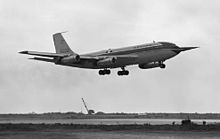Boeing 367-80
| Boeing 367-80 | |
|---|---|
 Boeing 367-80 in flight |
|
| Type: | Four - engined narrow-body aircraft |
| Design country: | |
| Manufacturer: | |
| First flight: |
July 15, 1954 |
| Commissioning: |
1954 |
| Production time: |
1954 |
| Number of pieces: |
1 |
The Boeing 367-80 is the four-engined aircraft prototype both for the successful Boeing 707 passenger jet series and for the military transporters of the C-135 family, which are built in almost as large numbers . The unique piece presented in 1954 with the civil aircraft registration number N70700 was called "367-80", but was not based on the propeller-driven Boeing 367 and is therefore usually only called "Dash 80" or "Dash 80". The prototype was used for tests until 1972, for example for components of the Boeing 727 or the supersonic Boeing 2707 project , and is currently on display at Washington.
history
At the beginning of the 1950s , Boeing began to develop plans for a passenger aircraft with the then new jet propulsion system . In order not to have to raise the estimated high development costs alone, the manufacturer tried right from the start to win the US Air Force (USAF) as a customer.
Boeing called his design Model 367-80 , based on his model 367, which was also used as a C-97 by the US Air Force as a KC-97 tanker . Internally, Boeing called the project the 707 early on , but continued to use the name 367-80 externally. The USAF initially showed no interest, so Boeing decided to build a prototype at their own risk . Production began at the end of August 1952 and ended with the rollout on May 14, 1954 . This usually only briefly Dash 80 (English dash: dash) called plane flew despite interim suspension span two months later on July 15 for the first time. By then, Boeing had invested $ 16 million. The machine soon received a refueling device with a rigid boom, which was convincingly demonstrated to the Air Force, so that on August 3, 1954, they ordered the first 29 copies of the KC-135A as a combined transport / tanker aircraft. Compared to the Dash 80 , the military series models have been significantly modified and further developed. At the request of the Air Force, they were given a 30 cm wider fuselage.
After a civil demonstration flight in August 1955, during which the pilot demonstrated two barrel rolls on his own initiative, the major US airlines were also convinced of the model's performance. Pan Am started on October 13, 1955 and ordered 20 machines of the new type 707-120 based on the Dash 80 . In order to be able to accommodate three and three seats in the cabin instead of two and three seats per row, the fuselage had to be widened again by 10 centimeters compared to the KC-135. The new civil series was officially given the model number 707, making it the first civil aircraft type from Boeing with the now classic 7X7 designation. The maiden flight of a 707-120 took place on December 20, 1957, and delivery to the airlines began in August 1958.
The military series was referred to internally as the Model 717, which is why the 707 was not followed by a 717, but by the Boeing 727 . After Boeing and McDonnell Douglas merged in mid-1997, the McDonnell Douglas MD-95 has officially been called the Boeing 717 since the beginning of 1998 .
The prototype Dash 80 with the registration number N70700 served Boeing as a test aircraft. In the meantime, it received a fifth engine at the stern, among other things, in order to test this arrangement for the Boeing 727 , it flew with up to three different engine types at the same time and experiments were carried out with other landing gear, paintwork, flap systems and radar antennas. After about 3,000 hours of flight time, it was retired in 1972 and given to the Smithsonian's National Air and Space Museum . In the early 1990s , Boeing restored the machine true to the original and it flew for the last time on August 27, 2003. Since then it has been on display at the Steven F. Udvar-Hazy Center near Washington Dulles International Airport .
Technical specifications
| Parameter | Data |
|---|---|
| length | 39.0 m |
| span | 39.5 m |
| Wing area | 223 m² |
| height | 11.6 m |
| Hull diameter | 3.36 m |
| Empty mass | 41.8 t |
| Takeoff mass | 72.6 t |
| Cruising speed | 885 km / h |
| Top speed | 935 km / h |
| Max. Altitude | 13,100 m |
| Range | 5680 km |
| Engines | four Pratt & Whitney JT3s with 44.5 kN each |


